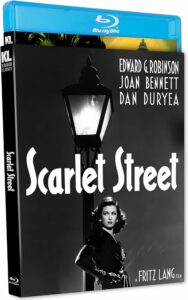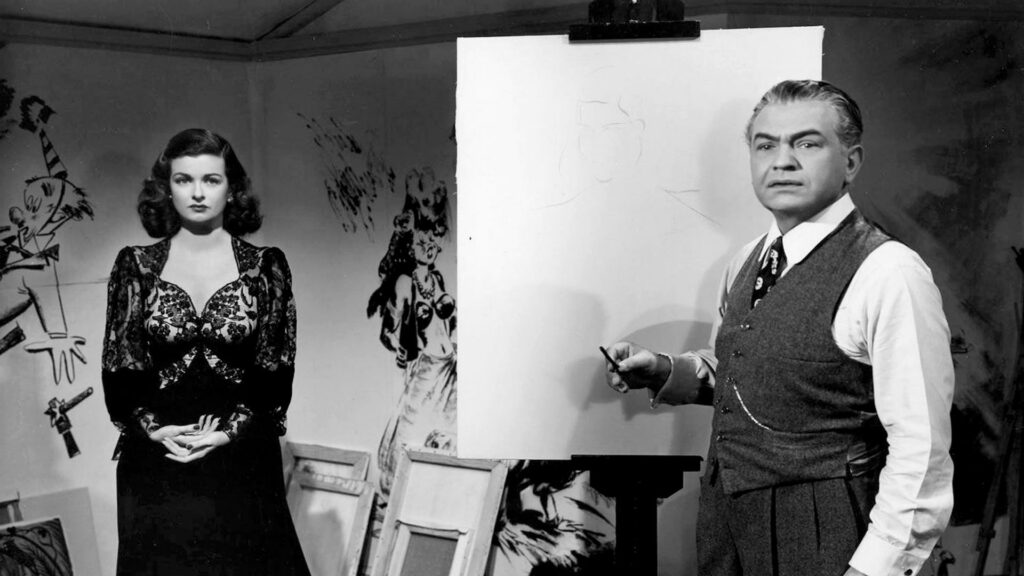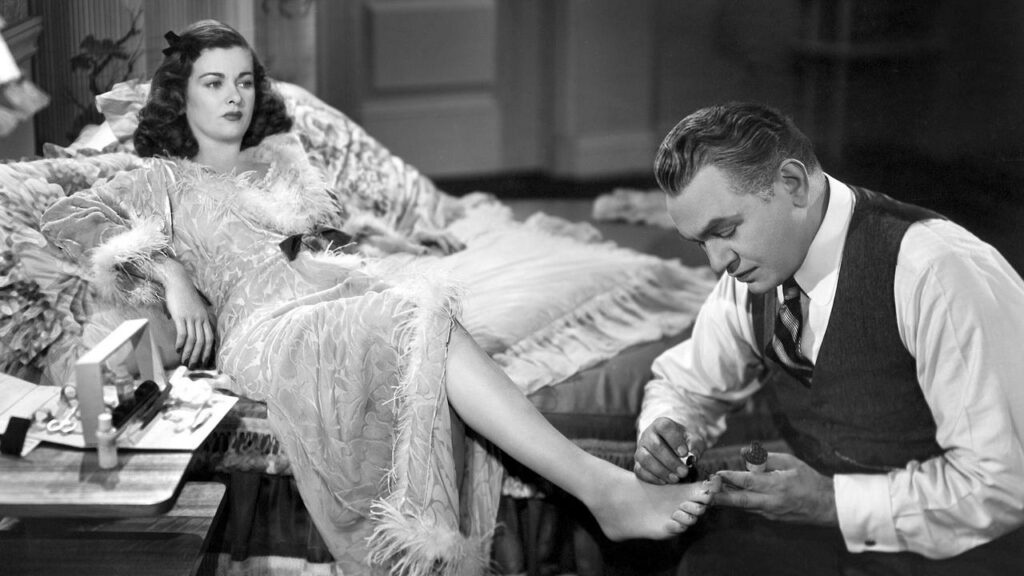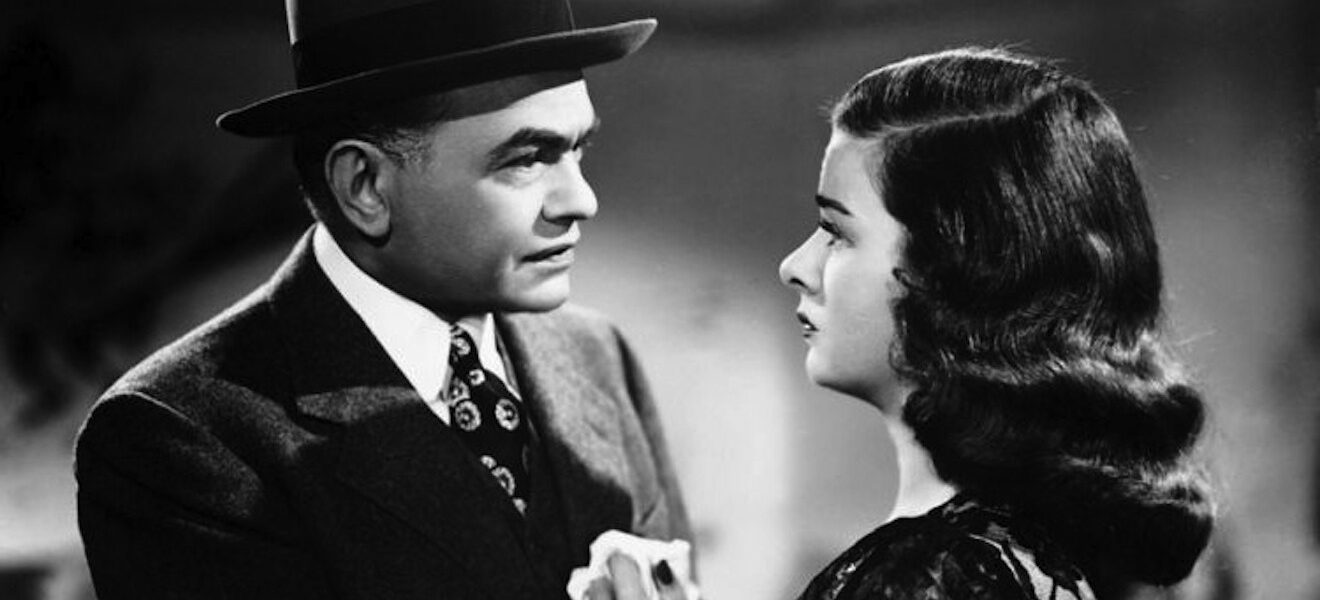For Cat’s Sake
Directed by Fritz Lang
Starring Edward G. Robinson, Joan Bennett, Dan Duryea
Released December 28th, 1945
Unrated

Christopher Cross (Edward G. Robinson) always wanted to be a painter. He wound up working as a cashier. When his boss awards him an engraved watch for his twenty-five years of service, his co-workers seem more joyous about it than Christopher. He finds his joy painting in his spare time, though he is unsure if he possesses any talent. A rare evening of staying out late leads to Christopher’s path crossing with an alluring younger lady, Katherine “Kitty” March (Joan Bennett). Though Christopher is aware he’s old enough to be her father (and says as much), he is smitten, and the pair have coffee. Kitty says she is an actress, though it’s a safe bet she works the street at night. Christopher tells Kitty that he is a painter, and she assumes he is famous in the art world, and rich, to boot. Later, when Kitty tells her hotheaded fiancé (and pimp?) Johnny (Dan Duryea) about Christopher, they decide to play him for a fool and take him for all he’s worth.
Christopher has endured five years of a loveless marriage to Adele (Rosalind Ivan), the widow of Homer (Charles Kemper), a cop who drowned years ago in the East River. A portrait of Homer hangs in their small apartment, forever smirking. Adele enjoys belittling her current husband at every turn, comparing her current husband unfavorably to her former, and discouraging his desire to paint. Christopher doesn’t stick up for himself much. His self-esteem is non-existent, his emasculation on full view as he wears an apron as he goes about household kitchen duties, making dinner and washing dishes.
Christpher makes time every chance he gets to meet up with Kitty. He shows her his amateurish paintings. He gazes at her longingly. He talks about the life they could share together. He falls for her hard, saying it’s the first time in his life he’s ever been happy. In Kitty’s private conversations with Johnny, we find that Christopher’s adoration of her is nothing more than an annoyance to be shouldered until they score their big payday at his expense. She’s worried they’re not moving fast enough, saying “I’ve been out to dinner with him three times this week, and now he’s talking about breakfast.”

Even after reading that the film was banned in multiple states due to its content, I was not prepared for the severity of the ending of Scarlet Street, which mixes a cacophony of disembodied voices and flashing neon lights as a character descends into madness, forever haunted by what has transpired. It’s truly wonderful cinematic storytelling.
Produced and directed by legendary filmmaker Fritz Lang, Scarlet Street is based on La Chienne, Georges de La Fouchardière’s 1931 novel, which was previously adapted for the big screen by Jean Renoir. Lang’s version was adapted by Dudley Nichols of Bringing Up Baby fame, who received an Academy Award nomination for Best Adapted Screenplay for his work. The paintings featured in the film (including an iconic one of Joan Bennett as Kitty) were painted by John Decker. H. J. Salter provided the film’s score, and the lush cinematography is courtesy Milton R. Krasner. Scarlet Street feels more confident (and has a much better ending) than The Woman in the Window, an earlier, somewhat similar film from the same director, cinematographer, and leads of Scarlet Street.
It’s interesting seeing Edward G. Robinson, an actor best known for tough guy roles, playing an innocent wide-eyed dreamer. He’s mostly sympathetic, though eventually downright pathetic. Joan Bennett, in the third of her four collaborations with Fritz Lang, cuts an imposing figure, dressed to kill and enjoying every moment playing out her con game. Her performance is cold, sexy, cruel, and supremely watchable. Robinson and Bennett have great chemistry on screen, and you can tell they trust each other to elevate their respective performances.

In Scarlet Street the traditional gender roles of the era are reversed, with Christopher being subservient and Kitty being in control. That the film allows a woman to be as crooked and without remorse as any male character of the time not only set the stage for many noir pictures to come but could be considered something of a feminist statement. Kino Lorber did not provide their new 4K release for review, but their Blu-ray disc sports a fabulous transfer, boasting a bright black and white composition that makes the film come across vibrantly. The phrase “For cat’s sake” is said a number of times in Scarlet Street. It’s not a colloquialism I am familiar with, but it tickles my fancy enough for me to pledge to do my level best to incorporate it into my daily vernacular.


